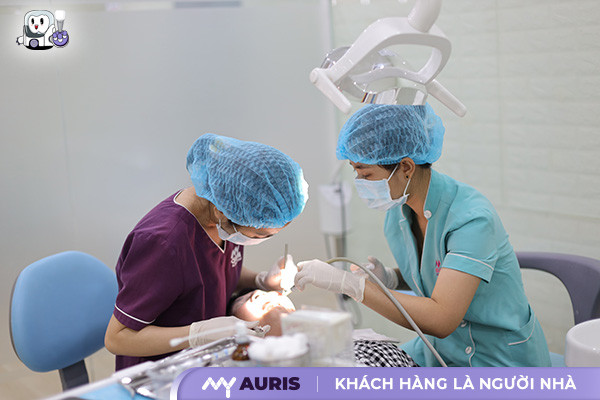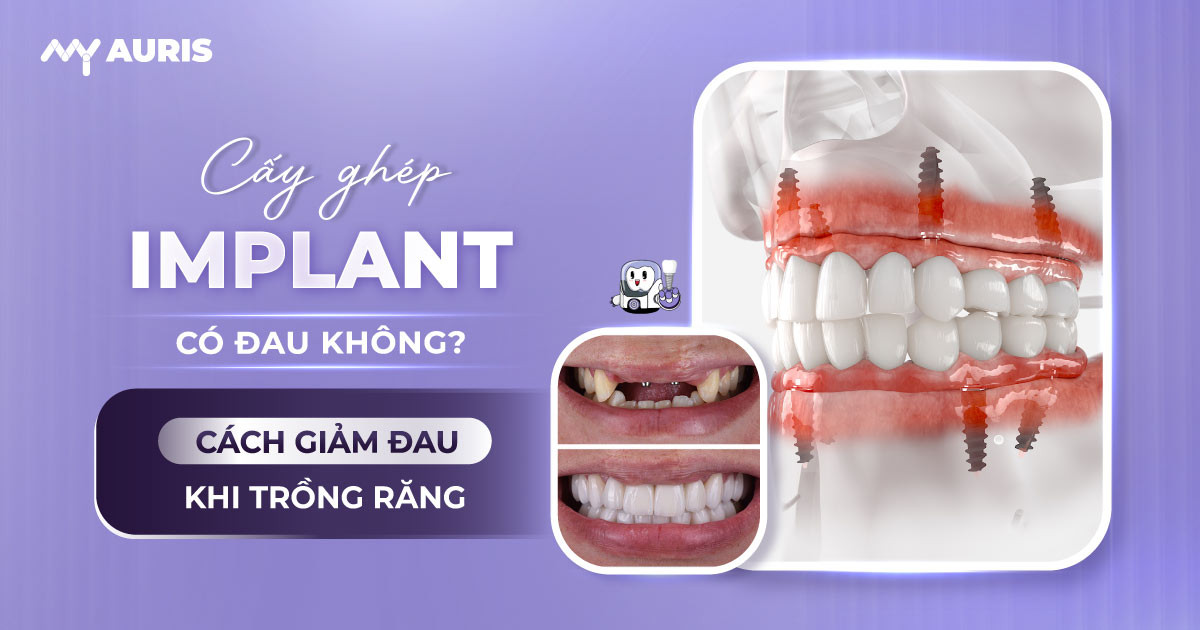Dental implants are a modern orthodontic method that helps restore lost teeth, bringing high aesthetic results and improving chewing ability. However, many people are still worried about whether dental implants are painful. The following article My Auris Dentistry will help you answer this question!
Is implant painful?
When it comes to dental implants, many people easily imagine the pain caused by drilling or screwing into the jawbone. However, in reality, this procedure is much gentler than tooth extraction. Thanks to local anesthesia, the patient remains completely awake throughout the procedure without feeling pain. In some special cases, general anesthesia can also be used to ensure absolute comfort.
Normally, during the implant surgery process, the patient will not experience pain, especially when the gum tissue and jawbone are healthy. If you are still worried, the doctor may prescribe additional painkillers or sedatives to support the patient’s psychology.
This technique itself does not cause pain because the mouth area is completely numb before surgery. After implantation, some people may feel slight post-implantation pain, but the level is insignificant, even less than the pain caused by tooth extraction. However, if the implant is incorrect or an infection occurs, the pain can last longer and become more severe.
Currently, implant placement is a popular technique, not only helping restore chewing function but also bringing a natural smile, long-lasting teeth and the feeling of normal eating and drinking activities like real teeth. This is the optimal choice for those who want to regain confidence and sustainable quality of life.

Factors that affect the feeling of pain during implant placement
There are many factors that affect this feeling, and understanding those factors will help you prepare better mentally and physically. quality.
Dental anesthesia technique
Local anesthesia is an important step in the dental implant procedure. If anesthesia is performed correctly, the patient will not feel pain during the process of implanting the post into the jaw bone. AfterWhen the anesthetic wears off, a feeling of pain may appear, but it is usually only mild to moderate and can be controlled with regular pain relievers. Prolonged pain often occurs if the anesthesia or surgical procedure is not optimal.
Loss of tooth loss and jaw bone condition
Influence of implant location great enough to cause pain. Implant placement in the lower molars is usually less painful due to good bone density and fewer nerves than in the front teeth area. In addition, people with strong jawbones often recover faster and with less pain than people with bone loss or previous bone grafting.
The number of implants needed
The number of implants needed is as high as possible. The longer the procedure takes, the longer the procedure will take and the level of pain after the procedure also tends to increase. In the case of full-mouth dental treatment or fixed dentures with multiple implants, the patient needs to be carefully monitored during the recovery process to limit implant complications and better control pain.
Dentist skills and dental implant process implant
The dentist’s skill plays a decisive role in the level of pain. An experienced doctor will properly perform the dental implant procedure and help minimize the impact on gum tissue and alveolar bone. In addition, the modern dental implant system combined with the Cone Beam CT scanner supports precise positioning of the position where the dental implant needs to be placed, helping the implant to take place faster and with less pain.
Type of implant abutment and artificial tooth structure
Dental titanium posts are designed to integrate well biologically with the jawbone. However, if the patient is allergic to metal or chooses an inappropriate type of cylinder, the pain may last longer due to the body’s reaction. Choosing popular implants from a reputable brand will help limit tissue inflammation around the implant or loss of gum sensation after surgery.
Overall health status and patient psychology
People who are in good health and do not have chronic diseases such as diabetes or high blood pressure often recover faster and feel less pain. Fear of pain before dental implant placement is also a factor that increases discomfort after surgery. A stable state of mind will help the post-transplant recovery process go more smoothly.
Post-operative care directly affects the feeling of pain
After implanting directly into the jawbone, patients need to follow post-operative care instructions. If good hygiene is not maintained, infection can occur causing lasting pain. Eat properly, take medication as prescribed, avoid contact with the implant area and tRegular check-ups are a way to reduce the risk of toothache and increase the likelihood of permanent survival of dental implants.
How to effectively reduce pain when having dental implants?
Pain after dental implants is a common concern. However, if you clearly understand the cause and know how to handle it properly, most patients can effectively control their pain. Below is a practical guide to help you significantly reduce pain after dental implants:

Use pain relievers correctly Dosage, right time
Immediately after surgery, the dentist will prescribe painkillers and anti-inflammatory drugs. You need to take the correct dose, on time, even if you don’t feel any obvious pain. Regular maintenance helps prevent pain flare-ups after the anesthetic wears off. Do not arbitrarily increase the dose or skip the dose because it can affect the liver, kidneys and gum tissue recovery process.
- If you have a lot of pain in the first 48 hours, you can use nonsteroidal anti-inflammatory drugs (NSAIDs) as directed by your doctor.
- Absolutely do not use strong pain relievers such as opioids without a prescription.

Cold compresses properly in the first 24–48 hours
Apply a cold compress to the outer cheek at the implant site in the first 24 hours to help constrict blood vessels, reduce swelling and limit radiating pain. The compress should be applied for about 15–20 minutes at a time, 1 hour apart.
- Use a specialized ice pack or ice wrapped in a thin towel.
- Avoid applying ice directly to the skin as it can cause frostbite.

Eat properly to avoid damage to the implant area
Eating directly affects the recovery process and pain sensation. You should: Eat soft, cold, easy-to-swallow foods for the first 3 days. Avoid chewing on the side with the implant for at least 7 days. Do not use spicy, hard, or hot foods because they will stimulate the gum tissue and the jawbone area where the implant is being integrated.
Keep oral hygiene carefully but not vigorously
Need to clean your teeth after every meal to avoid bacteria from entering. However: do not use toothpicks or dental floss near the newly implanted site. Use a super soft bristle toothbrush and non-alcoholic mouthwash. After 3-5 days, you can use a mild water flosser for more thorough cleaning.
Re-examine on schedule for timely check and treatment
After getting a dental implant, you need to return to the dental clinic for an appointment. The dentist will check the implant post, gum tissue and bone integration status. If there are unusual pain symptoms such as sharp pain, pus swelling, loss of gum sensation… then this may be a sign of complications such as inflammation of the tissue around the post, requiring early treatment.
Keep a relaxed mind, avoid prolonged anxiety
Feeling anxious and stressed can make you feel the pain more clearly light, meditate or simply rest more in the early days.





